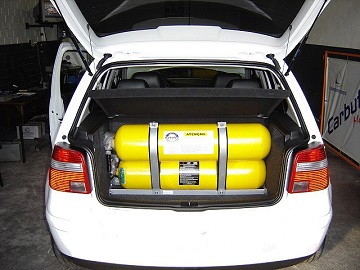Compressed natural gas

Compressed natural gas or CNG is simply natural gas - with the main component being methane - that is stored under high pressures (while remaining in its gaseous form) mainly as a means to transport it or as storage for later use as a vehicle fuel. In this form, it remains clear, odourless, and non-corrosive.[2] CNG is used widely as an alternative fuel for vehicles as it has a fairly high octane rating. CNG is not to be confused with liquefied natural gas, which has been turned into a liquid (and LNG must also be at very low temperatures). Although still in its gaseous form, compressed natural gas is under more pressure and thus takes up a smaller volume than ordinary natural gas (but more volume than LNG).
Storage and Transport
After being extracted from wells and treated, the gas travels through pipelines to a distributor. These distributors then send this fuel out to customers in pressurized tanks or sent out to fueling stations.[2] At smaller fueling stations and in vehicles, the compressed gas is stored in thick-walled tanks made of aluminum, steel, or some composite.[2] These high pressure tanks are kept at pressures around 20-25 MPa, 200-250 bar, or 3000-3600 psi.[3] This high pressure reduces the volume of the natural gas to less than 1% of its volume at standard atmospheric pressure.[4]
Use as an Alternative Fuel
CNG can be used as a gasoline alternative in a number of different vehicles and many commercial vehicles have recently become CNG fueled. Vehicles of any sizes from sedans to heavy-duty transit vehicles like buses and street sweepers can be fueled by CNG.[2] Currently, natural gas powers more than 12 million vehicles on the road with about 250,000 of these located in the United States.[4]
There are several benefits to using natural gas as an alternative fuel for transportation. In the US, the fact that more than 99% of the natural gas used comes from domestic or North American sources is a major benefit because of the heavy reliance of the economy on foreign oil.[2] Additionally, it burns more cleanly than gasoline or diesel fuel - showing an average reduction in emissions of 80% as compared to gasoline vehicles.[2] Additionally, current estimates say that compressed natural gas costs about 40% less than gasoline.[2]
Safety
Natural gas is flammable, however a leak is not always extraordinarily dangerous. Because natural gas is lighter than air, it quickly dissipates when it leaks out of a tank and it is only flammable when the air/natural gas mixture is 5-15% natural gas.[2] Additionally, a sulfur-based mercaptan - an odourant - is added to make leaks more simple to detect.[3] This narrow flammability range makes it a safe fuel to use, but strict safety standards exist to make CNG powered vehicles as safe as those powered by gasoline.[4] There are some safety concerns with large buses fueled by CNG compared to diesel buses. One of these is a longer breaking distance due to the added weight of the fuel storage system. Finally, the composition of natural gas itself can be an issue. CNG is mainly methane - a greenhouse gas - which could contribute to climate change if a leak existed.
References
- ↑ Wikimedia Commons. (June 3, 2015). Carroagas [Online]. Available: http://fr.wikipedia.org/wiki/Gaz_naturel_pour_v%C3%A9hicules#/media/File:Carroagas.jpg
- ↑ 2.0 2.1 2.2 2.3 2.4 2.5 2.6 2.7 Consumer Energy Center. (June 3, 2015). Compressed Natural Gas [Online]. Available: http://www.consumerenergycenter.org/transportation/afvs/cng.html
- ↑ 3.0 3.1 Alternative Fuel Systems. (June 3, 2015). What’s the difference between CNG, LNG, LPG and Hydrogen? [Online]. Available: http://www.afsglobal.com/faq/gas-comparisons.html
- ↑ 4.0 4.1 4.2 CNG Now. (June 4, 2015). What is CNG? [Online]. Available: http://www.cngnow.com/what-is-cng/Pages/default.aspx

